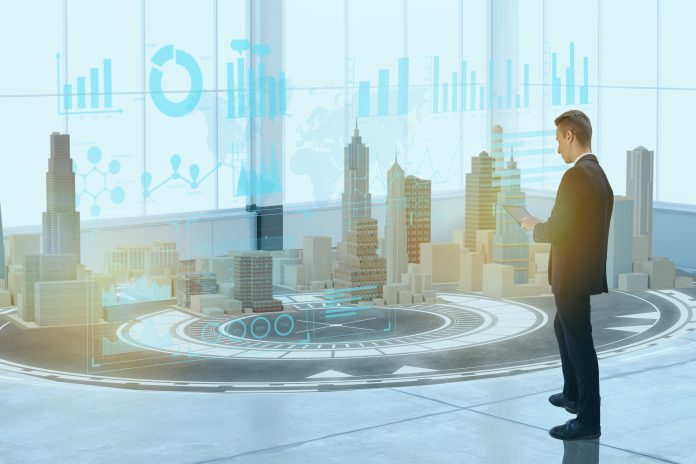In this piece, Linda Wade, CEO of Spinview, will look at how visually intelligent digital twins can tackle urban decarbonisation and support decision-makers within the built environment in a climate-resilient future
The end of 2022 saw COP27 reignite the discussion around how technology can support a low-emissions, climate-resilient future. And digital twins are a huge part of the conversation. Digital twins will be vital in tackling building emissions and the decarbonisation of cities. Research from Ernst & Young suggests that digital twins could reduce urban carbon emissions by more than 50% while also reducing operating costs for asset owners by 35%. But how?
Urban decarbonisation starts with buildings
Buildings still consume up to 40% of the world‘s energy and emit 33% of the world’s greenhouse gases. Cement production alone accounts for about 7% of the world’s CO2 emissions and is the largest contributor to carbon in the built environment.
And while there has been some notable successes in reducing the operational carbon of built spaces, decision-makers need to and want to go further, reducing the carbon generated by the built assets themselves, also known as embodied carbon. This includes emissions caused by the extraction, manufacture, processing, transportation and assembly of every product and element in that asset. Embodied carbon is expected to account for nearly 50% of the overall carbon footprint of new construction between now and 2050.
Still, decision-makers’ biggest challenge is knowing where to start and assembling an aligned environmental strategy remains a pain point. This is because collecting complex data sets and combining them into one place can be difficult, never mind mining it for insights. Most organisations have vast amounts of “dark data”, existing in disparate formats and siloed systems that decision-makers can’t holistically access, much less interpret. On top of that, there is data on emissions and other invisible particulate matters that you may not have yet captured.
So, how can organisations collect, connect and communicate this data?
Enter the digital twin.
A digital twin is, in short, a 3D construction of your space that, when connected to various data sets from the real world, serves as a living, breathing recreation of your building or asset.
It responds and behaves like its real-world counterpart, allowing decision-makers to remotely manage anything in their space. From insight and management of environmental emissions to forecasting the future performance of any asset or space, digital twins are quickly becoming indispensable.
For sustainability planners, one of the most critical data sets for an effective digital twin comes from environmental and health-based sensors. By monitoring “invisibles” such as emissions, pollutants, humidity and noise, these devices generate a steady stream of environmental data that delivers powerful insights into how your asset performs against an agreed set of criteria.
But collecting and connecting this information within a digital twin isn’t enough. People must be empowered to act on these insights. To do this, an advanced level of communication is needed – constantly communicating that provides dynamic guidance and actionable intelligence to the people who need it.
This advanced level of communication is called Visual Intelligence (VQ)
VQ is rapidly improving our ability to understand, communicate and, most importantly, respond to what the data in the digital twin is telling us. It involves translating data from mere information into a dynamic source of visual and actionable intelligence for everyone involved in the operation of your built environment.
The secret ingredient in managing carbon footprint: VQ
Once sensor-based environmental data is overlaid with a 2D or 3D digital twin, VQ creates a golden thread of rich visual insight that allows you to see your data in situ and to observe how changes impact the space and environment either in a moment, in recurring time slices or as a predictor of future states.
Thus, VQ is good news for companies striving towards arbitrary net zero targets with little or no idea where they are today. Assisted by a VQ-powered digital twin, planners can establish a factual baseline of their assets and assess how far off their net-zero targets.
Additionally, a VQ-powered digital twin allows decision-makers to visualise, assess and resource future scenarios. This helps set realistic targets and roadmaps, shedding light on which levers to pull for energy savings. Above all, a VQ-powered twin translates all the data in ways that employees can understand and act on. Companies such as the UK’s Transport for London (TfL) and Swedish property company Kvalitena are both examples of businesses tackling urban decarbonisation and ensuring climate resilience, looking to explore visual intelligence within their space.
Digital twins to empower urban decarbonisation
Digital twins, augmented by VQ, will be integral in empowering everyone who needs a holistic view of the environmental footprint – from decision-makers and asset owners to maintenance staff – to act with real-time, pinpoint accuracy to manage its impact.
With visually intelligent digital twins, real strategy can be implemented, and real action can be taken, ensuring a climate-resilient future.
 Linda Wade
Linda Wade
CEO
Spinview

















